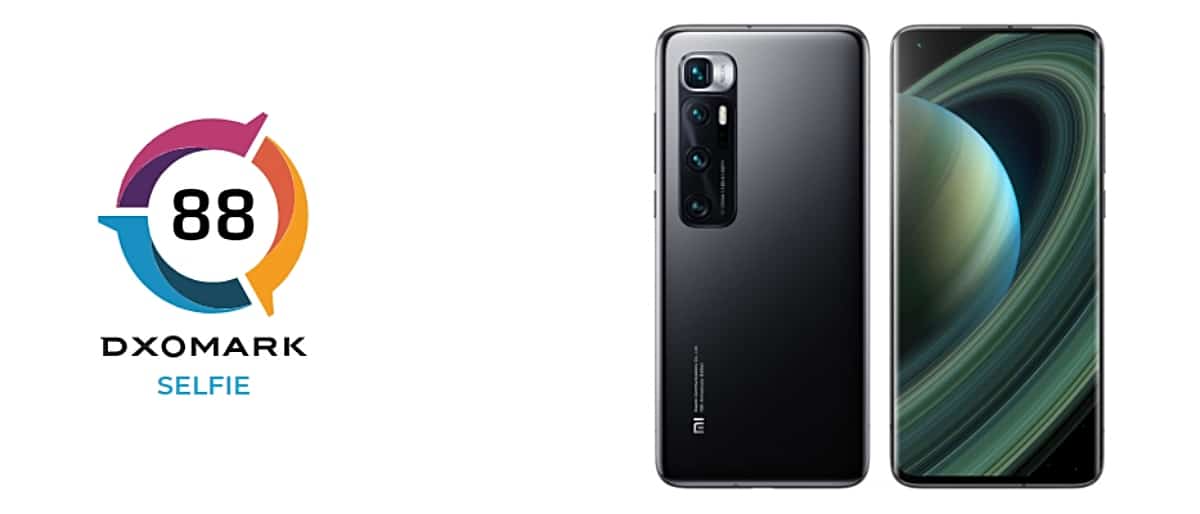
El Xiaomi mi 10 ultra It is currently the flagship phone and the most advanced of the brand. This hit the market in mid-August, about four months ago. This device claims to be one of the most complete on the market, which corresponds to its range, but one of the sections that stand out the most from the competition is its cameras, which have proven to be top class. However, while its rear camera module is enviable, the front shooter is less so.
Recall that the front sensor responsible for taking selfies photos of the smartphone is one that consists of a resolution of 20 megapixels and an aperture f / 2.3. This one offers good shots, but what DxOMark has revealed in the review of this sensor places it well below the selfie cameras of other mobiles of the same range As would the Huawei Mate 40 Pro, Galaxy S20 and Note 20, iPhone 12 and even mobile phones like the Galaxy S10. This is especially curious because in the top of rear cameras the terminal is in the second position, and in this selfie ranking it is in position number 22.
The front camera of the Xiaomi Mi 10 Ultra is good, but ...
With a score of 88 on the DxOMark selfie camera ranking, the Xiaomi Mi 10 Ultra ranks among the best in the ranking, without being within the top 10, yes, keeping company with the strong phones of last year (it falls between the Huawei P30 Pro and the OnePlus 7 Pro). This is a bit better than its brother Mi 10 Pro, but a big departure from the graphics assault performance of its main camera system.

Photo taken with the front camera of the Xiaomi Mi 10 Ultra | DxOMark
The Mi 10 Ultra still achieves good selfies if the conditions are not too challenging. Exposure is generally accurate. The fixed focus lens is properly optimized for close focus, but the depth of field is not deep enough to keep backgrounds sharp. In addition, the color is quite neutral, although the color reproduction is not a strong point for the camera. The main weakness here is the limited dynamic range, which will mean clipped reflections when shooting scenes with a wide range of brightness, highlights DxOMark in its review.
Most of the Mi 10 Ultra's gain comes from the video score, and most of that boost comes down to a massive improvement in stabilization performance.

Source: DxOMark
Exposure is generally accurate. The Mi 10 Ultra achieves good exposures down to very low light levels in laboratory tests. In the most subdued conditions, the tested exposure begins to decline, but not more than some leading devices. However, when it comes to capturing high-brightness scenes, the Mi 10 Ultra, like the Mi 10 Pro, really struggles compared to the best of the competition. The lens exposure is also sometimes a bit low when HDR processing is activated. In direct sunlight, reflections on the face can also be an unflattering problem.
DxOMark goes on to say that the front camera on the Mi 10 Ultra often delivers nice and vivid colors, but playback errors are occasionally visible. White balance is generally neutral and fairly accurate outdoors and indoors with moderate light levels, but color casts sometimes appear in low light. In low light, the testers noticed some shades of color.

Source: DxOMark
The fixed focus lens on the Mi 10 Ultra is optimized for a typical 50cm outstretched selfie distance. It's also pretty sharp at 30cm and still acceptable at a distance of 120cm (where it's slightly sharper than the Mi 10 Pro, albeit smoother than you'd expect from an autofocus system). In group selfies, it is noted that despite the simple fixed focus design of the front camera on the Mi 10 Ultra, the lens' deeper depth of field keeps subjects further away sharper than those of Huawei or Samsung, which have AF but have a limited depth of field due to their larger sensors.
The front camera of the Mi 10 Ultra also captures a lot of details, especially in bright light, but fine luminance noise is almost always visible. The intensity is gradually reduced below 100 lux, and even in very low light the camera captures an acceptable level of detail. Backgrounds are always a bit soft, but this is due to the fixed focus lens, not the sensor.
The Mi 10 Ultra improves its artifact score over the Mi 10 Pro, but it is still very prone to flare and loses the most points for that glitch. The tone shift is visible in the skies as they erupt, and DxOmark testers also noted anamorphic distortion towards the edges of the frame and some color quantization.
